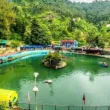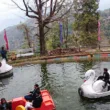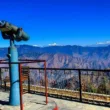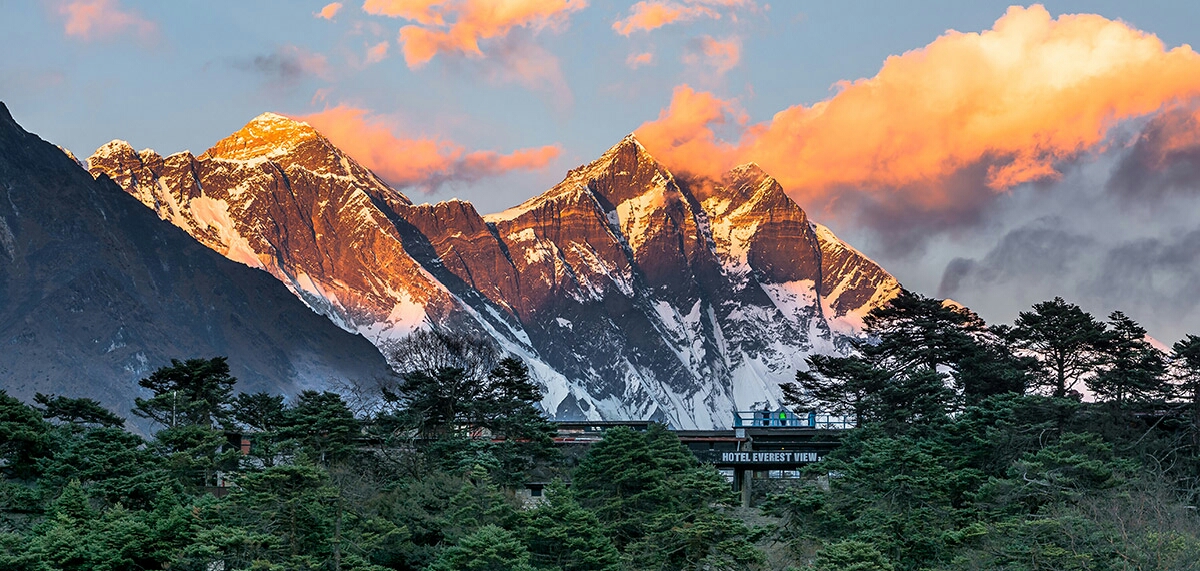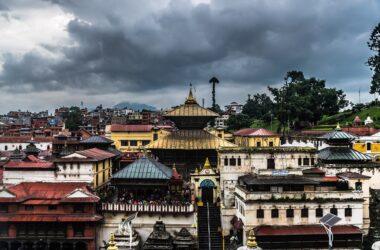KATHMANDU VALLEY : Discover ancient temples and monuments in the Valley of the Gods where Hinduism and Buddhism coexist in perfect harmony. Learn about the myths and legends that have shaped the lifestyle of Nepalese through the centuries since ancient times.
Savor traditional Newari food cooked on wood ovens as you stroll the charming little lanes around the court squares of Kathmandu Valley’s three cities; Bhaktapur, Patan or Kathmandu.
Buy handicrafts from artisans working according to age-old traditions. Admire the exquisite architecture and exquisite wood carvings of Newar craftsmen, whose artistic talents are displayed around the three cities in the form of temples and monuments built centuries ago.
See how the people of the valley still use their temples to practice rituals that have been passed down from generation to generation. Enjoy the colorful festivals of the valley involving gods and goddesses including the living goddess Kumari on many occasions. Follow the chariot processions that move through the narrow streets of old Kathmandu.
Visit 7 monuments designated as UNESCO World Heritage Sites around Kathmandu in 48 hours.
There is a popular folk tale that talks about the founding of the Kathmandu Valley. Long ago, during the Pleistocene era, the Kathmandu Valley was a vast lake – a beautiful display of aquatic flora and fauna. Around the same era, when Manjushri, a holy Buddhist saint from Tibet, saw a beautiful lotus flower floating in the center of the lake, his heart began to grow with immense admiration, awakening his devotion to holding and worshiping the flower .
They then cut the Chobar Hill, which can now be seen as a deep moat, which drains the lake water, leaving a fertile valley for human settlement. The settlement later became a famous terminal for diverse peoples: Hindus and Buddhists, Tibetans and Indian merchants, artisans, emperors, explorers, historians and other devotees.
Kathmandu Valley has always been a melting pot of diverse cultures, religions, arts and crafts. The Gopala and Kirat dynasties ruled during the early period, followed by the Lichchavi (300-879 AD) who, accordingly, developed the city with a passion, traditional arts and religious beliefs.
The many dynasties that ruled the valley have left a rich legacy in the form of cultural and religious harmony. Various Hindu temples and Buddhist monasteries have stood next to each other for centuries. Kathmandu enjoys diverse ethnicities, colorful festivals and countless celebrations.
The Kathmandu Valley includes three historical cities – Kathmandu, Patan and Bhaktapur, which were once independent kingdoms ruled by Malla kings, who ruled the cities from the 12th to the 18th centuries and built monuments to glorify their rule. competed with another. and temples that showcased the craftsmanship and architectural prowess of the Newar artisans. This was a time when even the mighty Mongol emperor Kublai Khan hired extraordinary craftsmen from the Kathmandu Valley to glorify his empire.
The famous pagoda style architecture is a gift to China from the Kathmandu Valley. Now the valley is home to seven sites that make the valley a UNESCO Cultural World Heritage Site, a reminder of the golden age of Nepalese architecture.
WHAT TO SEE IN KATHMANDU VALLEY
BHAKTAPUR
Of the three major cities in the Kathmandu Valley, Bhaktapur retains some of its ancient lifestyle, reminding you of what the entire Kathmandu Valley would have looked like during the medieval period. The remarkable architecture, exquisite wood carvings and metal crafts that can be seen around the city, date back to the times of the Malla rulers who patronized the art like no other dynasty. The pagoda style temples rise above the Bhaktapur skyline. Pottery Square, Palace (Durbar) Square which dates back to the 12th century where devotees still celebrate their centuries old festivals and Temple Square which is still alive are the major attractions of Bhaktapur. But apart from the elaborate festivals that have remained unchanged for centuries, it is the city’s ancient look that attracts tourists. Durbar Square is one of the UNESCO World Heritage Sites of the valley.
The Mallas once ruled the Kathmandu Valley from Bhaktapur to Raja Yaksha Malla in 1482, dividing the kingdom among his three sons, leading to splits and fading power. With the division of the kingdoms of the valley, the Shah dynasty from the Gorkhas was able to conquer them one by one.
Unlike Kathmandu and Patan, Bhaktapur has resisted rapid change, and large numbers of women in Bhaktapur are still seen in their traditional Newari attire in black and red. Making pottery, cultivating, singing in temples or sitting in rest houses in the morning and evening is a way of life which they have maintained for centuries. The city, once known as Bhadgaon (Nepali) and Khwapa (Newari), has retained its festivals in their original elaborate forms, many of which last more than a week. Following a restoration program in the 1970s, the city’s municipality has controlled the construction of new buildings to maintain the brick façade. One of the most popular festivals of Bhaktapur is the Biscuit Jatra which attracts a large number of tourists around the Nepali New Year.
PATAN
Patan is 5 km from the capital Kathmandu, and is reached by crossing the Bagmati River. Despite its proximity to Kathmandu, it still retains its old world charm and traditional occupations such as wood carving and especially metal crafts. As you pass through the city, you still hear the tapping of small hammers as a craftsman works on the statue or jewellery. Patan is full of temples and monasteries that look alike in their pagoda style architecture and wood carved windows. The district known as Lalitpur covers a vast area which includes nearby hills.
Patan is a city of 55 major temples, 136 Buddhist monasteries and its craftsmen are known for their exquisite metal works. The city celebrates countless festivals, both Hindu and Buddhist, many of which are spectacular such as the Rato Machendranath Jatra and the Dipankara Buddhas on display. Patan takes pride in producing great thangka and pauba painters whose works are exported to many countries. Such paintings can be seen in the small streets of the city.
The art is still thriving in this city of Newar craftsmen, who have traditionally been supplying metal crafts to Buddhist monasteries across the country. The population is predominantly Newars whose castes usually determine whether they are Hindu or Buddhist.
Patan Durbar Square (Darbar means palace), a UNESCO World Heritage Site, is the prime attraction with the old royal palace and artistically designed temples within the square. The Patan Museum within the palace has a fine collection of metal crafts, wood carvings and a precious Malla era throne. The beautiful Krishna temple made entirely of stone in Durbar Square is the most important Krishna temple in the valley. There are several restaurants and cafes just outside the square, some with terrace views. One notable terracotta temple worth visiting is the Mahabuddha, a Shikara-style temple with a thousand images of Buddha. Visitors enjoy Patan’s peaceful atmosphere and the primacy of art.
KATHMANDU CITY
Set in a vast valley following the flow of a large lake, this remarkable city has legends and a temple or two in every street. Kathmandu is an incredibly diverse, historic city with amazing architecture, exquisite wood carvings and metal crafts that showcase the skills of Newar artisans dating back centuries. Hinduism and Buddhism have co-existed in the Kathmandu Valley since ancient times and the inhabitants of the valley make little difference because of their worship in both Hindu and Buddhist temples.
Kathmandu is a city where ancient traditions are preserved as well as modern technology is adopted. The grandeur of the past enthralls the visitor who gazes upon an exquisitely carved wooden window frame, an 18th century bronze sculpture or a spiritually uplifting stupa. Kathmandu, the largest city of Nepal, is the political and cultural capital of the country, where Nepalis from all corners of the country have come and assimilated.
Like any major city, Kathmandu has seen rapid expansion over the past decade, but despite the fast-paced life of a metropolis, the people here remain fresh to visitors. Keeping its ancient traditions intact, Kathmandu is blessed with the living goddess Kumari, a small Buddhist girl who represents the mighty Hindu goddess Taleju. City life is enriched with endless ceremonial processions and events, which take to the streets all the time with hordes of devotees to revel in spiritual festivities. These religious festivals are steeped in mythology and are accompanied by chariot processions and masked dancers, often a spectacle with the spirits of the gods.
Durbar (Palace) Square, a UNESCO World Heritage Site, is located in the heart of the city along with the old palace, which houses a number of pagoda-style temples that boast superb craftsmanship in wood and metal. The abode of the living goddess is nearby and the famous Freak Street is a stone’s throw away. Today tourists love Thamel, which has grown into a thriving tourist destination, ranging from luxury to affordable hotels, generic Cialis, bars and eateries to travel agencies, money exchange centres, massage parlors, Nightclubs, live music, yoga and meditation classes and more are included. . Every kind of international cuisine from Korean to Italian, Chinese, Japanese, Thai, Indian to Mexican and much more is available within a square kilometer.
Pashupatinath, Buddhist and Swayambhu, the three major religious pilgrimage sites are World Heritage Sites and a must visit. These centuries-old places of worship, countless small temples and numerous festivals make Kathmandu a living museum, an opportunity to travel back in time while enjoying all the stuff of the 21st century.
More About World Heritage National Parks
- Khangchendzonga National Park – Experience Nature
- Great Himalayan National Park – What You Should Know
- Nanda Devi and Valley of Flowers National Parks
- Sunderbans National Park – Most Famous Tiger Zone
- Keoladeo National Park – Your Perfect Date With Nature
- Manas National Park – Handy Guide For Travelers To Visit
Frequently Asked Questions About Kathmandu Valley
Q. Where is Kathmandu Valley?
A – The Kathmandu Valley covers an area of 230 square miles (600 sq km) in the Bagmati region in central Nepal, and is home to three of Nepal’s largest cities, including Kathmandu, as well as hundreds of smaller towns. and village.
Q. What is special in Kathmandu?
A – Kathmandu is the perfect place to experience the rich cultural and heritage values. The city flourished with countless temples and historical monuments, allowing us to witness the glory of Kathmandu’s past.
Q. How was the Kathmandu Valley in the beginning?
A – Kathmandu History. According to legend, the Kathmandu Valley was created by the Buddhist saint Manjushri, who used his sword to breach the canyon wall by draining the vast lake that filled the valley in prehistoric times.
Q. Who founded the Kathmandu Valley?
A – It was founded by Parthivendra Malla in 1679 in memory of his elder brother, who replaced the earlier structures on the site. The ten incarnations of Vishnu and other Vaishnava deities were represented in the wooden struts supporting the three sloping tiled roofs.
Q. What is Bhaktapur famous for?
A – Bhaktapur has one of the best-preserved palace courtyards and old city center in Nepal and is listed as a World Heritage Site by UNESCO for its rich culture, temples and artifacts of wood, metal and stone. It is supported by the restoration and conservation efforts of the German-funded Bhaktapur Development Project (BDP).
Q. What are the major attraction of Bhaktapur Durbar Square?
A – Major attractions
- Nge Nyapa Jhya Laaykoo (55 window palace)
- Vatsala Temple.
- Statue of Bhupatindra Malla.
- Nyatapola Temple.
- Bhairava Nath Temple.
- Lun Dhwākhā (Golden Gate)
- Lion’s Gate.
- Mini Pashupati Temple.
Q. How did Bhaktapur get its name?
A – Bhaktapur is an ancient Newar city located in the eastern corner of the Kathmandu Valley, about 13 km (8 mi) from the Kathmandu Valley. The name Bhaktapur literally means “city of devotees”, thus one can expect to find a multitude of religious places, monuments and events in Bhaktapur.
Q. Who is the first king of Bhaktapur district?
A – After that it remained the capital of the entire valley for the next three centuries until the division of the valley into three kingdoms during the Malla dynasty. After fragmentation the first king of Bhaktapur was Yaksha Malla.
Q. How far is Patan from Kathmandu?
A – The calculated flight distance from Kathmandu to Patan is 862 miles which is equivalent to 1388 km. If you want to go by car, the distance between Kathmandu and Patan is 1752.6 kms. If you drive your car at an average speed of 112 km/h (70 mph), the travel time would be 15 hours 38 minutes.
Q. What is Lalitpur famous for?
A – Lalitpur is known for its craftsmen, especially metal workers and wood carvers. Durbar Square has some of the finest Buddhist temples including the temple of Machendranath. The city has several viharas, originally Buddhist monasteries, but now inhabited by the descendants of the priests who once occupied them.
Q. What is the old name of Patan?
A – In the modern era, the name of Patan was changed to Lalitpur. This historic city is the third largest city after Kathmandu and Pokhara. Patan is located in the south-central part of the Kathmandu Valley.
Q. How can I go from Patan to Kathmandu?
A – You can reach Patan from Kathmandu by bicycle, taxi, bus or tempo. The cost of traveling by taxi is around Rs 400. There is a taxi stand near Hakha Tola. Minibuses and tempos to Kathmandu converge at Jwalakhel near the zoo.

